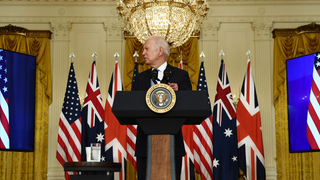AUKUS is a new trilateral partnership featuring Australia, the United Kingdom and the United States. Though it aims to deepen diplomatic, security and defence cooperation between the three states, AUKUS will focus specifically on deepening integration in defence-related science, technology, industrial bases and supply chains, with particular emphasis on cyber capabilities, artificial intelligence, quantum technologies and new undersea capabilities. The first initiative of AUKUS will be to support Australia in acquiring nuclear-powered submarines and the necessary infrastructure to upkeep them, while keeping with partners’ international obligations to the Non-Proliferation Treaty and International Atomic Energy Agency safeguards regimes.
On the one hand, it is symbolic for Australia that this partnership includes the country’s major historical and contemporary alliance partner. Yet the new partnership is unique from prior historical efforts between the three countries, and all the more significant, for its explicit focus on cooperation in the Indo-Pacific. In that sense, AUKUS is intended to complement the efforts of other partnerships and regional groupings, such as Five Eyes and the Quad, to develop coordination in areas including diplomacy, global governance, health security and intelligence sharing.
Besides the submarine deal, what else does AUKUS entail?
While the submarine initiative (more below) has dominated the headlines, the AUKUS partnership carries much wider significance in that it will see Australia, the United Kingdom and the United States expand their cooperation across a wide range of defence capability and critical technology areas. This kind of targeted cooperation on advanced defence technologies, capability acquisition and sustainment is intended to provide strategic payoffs for the Indo-Pacific region and distinguishes AUKUS from intelligence-sharing arrangements like the Five Eyes grouping, of which Canberra, London and Washington are members alongside Canada and New Zealand.
The three leaders identified artificial intelligence, cyber capabilities and quantum computing as priority areas for such cooperation and it would seem likely that this trilateral arrangement will expand cooperation to developing and sharing other military capabilities such as long-range missiles and underwater systems. Australia is seeking US support and technical know-how to develop a Sovereign Guided Weapons and Explosive Ordnance Enterprise, to manufacture long-range strike missiles in Australia; and both the United Kingdom and the United States are working on developing large unmanned underwater vehicles (UUVs) to operate in tandem with manned platforms on intelligence gathering and reconnaissance missions. AUKUS provides a clear opportunity for Australia to plug into and benefit from these efforts.
What are the benefits and challenges for Australia of having nuclear-powered submarines?
Nuclear-powered submarines will strengthen Canberra’s ability to deter major power aggression and threats to Australian interests in the Indo-Pacific, as called for in the 2020 Defence Strategic Update.
Compared to the diesel-electric submarines Australia was co-developing with France, nuclear submarines are quieter, faster, more survivable and have longer – if not limitless – endurance. This will allow Australia to deploy its future submarine fleet to distant Indo-Pacific locations for much longer periods of time, including to geopolitical hotspots like the South China Sea and parts of the Japanese archipelago.
If the US Virginia-class submarine design is what Canberra eventually builds – which is far from certain at this stage – it will provide Australia with a major increase in submarine-based strike power, given that this platform can carry up to 40 Tomahawk land-attack missiles and more. This would be a game-changing contribution to the Australian Defence Force’s foray into long-range strike capabilities, enabling Australia to independently and collectively hold Chinese forces at risk across a range of regional scenarios.
Where does this agreement fit into ongoing US-Australia defence initiatives?
The nuclear submarine plan fits into a number of existing alliance initiatives. Using the 2020 Australia-US force posture working group, this year’s AUSMIN is expected to deliver upgrades to the 2014 US-Australia Force Posture Initiative and 2017 Enhanced Air Cooperation program, possibly by adding a maritime component to the US Marine Corps and US Air Force initiatives underway. It is conceivable that this will include increased rotations of US submarines through HMAS Stirling in Western Australia. Operating US submarines out of Australia will significantly shorten their transit times to Western Pacific flashpoints from Guam, Hawaii or the continental United States, enabling a more persistent and robust forward US military presence. Increasing the tempo of US nuclear-powered submarine operations and maintenance out of Western Australia would support Australia in developing the technical know-how and skills needed to run a fleet of nuclear-powered submarines, particularly if Australian submariners and engineers are embedded on US submarines, as takes place between US and UK submariners.
The agreement is also welcome in the context of operationalising Australia’s involvement in the US National Technological Industrial Base (NTIB). Australia has been party to this agreement since 2017, but a combination of legislative, commercial and export control hurdles has limited the NTIB’s ambition to become a kind of defence free-trade zone among trusted partners. Many thought the Biden administration’s “worker centric trade policy” and “Buy American” agenda would restrict NTIB progress, potentially frustrating Australian efforts to build the Sovereign Guided Weapons and Explosive Ordnance Enterprise. Biden’s embrace of AUKUS has changed the equation, signalling presidential support for empowering close allies through defence industry cooperation and raising expectations of progress through the NTIB process.
What benefits could this agreement bring for the United States?
Establishing a local industrial base to construct and maintain nuclear-powered submarines in Australia will enable the United States to undertake more sustainment, maintenance and resupply of its nuclear-powered submarine fleet here. This has operational advantages: making Australia a more valuable hub for Indo-Pacific maritime and submarine operations and potentially opening the gateway for more expansive US-Australian posture arrangements.
It could help the United States relieve some pressure on its own submarine maintenance and shipbuilding base. The US submarine-building industrial base is under strain, pressures which are projected to significantly reduce the numbers of submarines available to the US Navy over the coming two decades. A recent Congressional Budget Office report estimated that, without major change, US submarine maintenance requirements would exceed shipyard capacity in 25 out of the next 30 years. COVID-19 has disproportionately affected submarine construction programs, which now require significant funding to put back on track, let alone get ahead of requirements.
These pressures are incentives for the US to transfer sensitive technology to Australia – with the UK assisting in submarine reactor technology – both as a way of building-up the submarine fleet of a close ally while US submarine numbers are strained and as a way of integrating Australia into its submarine supply chain to provide redundancy and surplus capacity in a critical part of the Indo-Pacific.
Are there likely to be any major hurdles to the project going forward?
Many of the plan’s finer details remain unclear, but moving the nuclear-powered submarine initiative forward will face challenges. For Australia, how to develop and sustain sufficient shipyard and maintenance capacity will be a crucial component of the 18-month study now underway. Job creation and retention will be high on the government’s priority list, considering the controversies surrounding the involvement of Australian industry in the Attack-class program. The government will also have to deal with Australian political and public sensitives regarding all things nuclear. Prime Minister Morrison stressed that Australia was not seeking to establish a civil nuclear program or develop nuclear weapons; and the AUKUS proposal has already received bipartisan political support. But the initiative could still hit a nerve with the public. Polling in 2019 saw a small rise in support for nuclear power generation in Australia, but more recent figures show that over 60 per cent of respondents are against the idea of Australia pursuing nuclear power capability.
How much will it cost to switch programs? Does this affect the delivery timeline for Australia’s next-generation submarines?
The projected costs for what are expected to be at least eight nuclear-powered submarines remain unclear. However, some estimates suggest that the price tag will exceed the A$90 billion price tag for the Attack-class. Originally estimated to cost A$50 billion at the time of the contract’s announcement in 2015, the price tag for twelve boats has steadily grown to nearly double that size, with recent Defence advice to Senate estimates putting the project at nearly AUD $90 billion. Of that figure, Prime Minister Morrison has indicated that nearly A$2.5 billion has been spent on the Attack-class program to date. On the other hand, abandoning the Attack-class project will almost certainly incur substantial cancellation fees, which could amount to anywhere between A$140 and A$400 million depending on which design stage the project was in at the time of its termination.
In terms of when the new submarines will become operational, the government expects that the first boat is likely to be in the water before the end of the next decade. That’s roughly the same time as the first Attack-class could have been expected to do the same. In any case, Defence Minister Peter Dutton confirmed in June that Australia’s current fleet of six Collins-class submarines would undergo full service life-extensions to fill the interim gap, a process likely to cost around AUD $6 billion.
How has the announcement been received in the region so far?
Reflecting the importance of these relationships, Prime Minister Scott Morrison briefed his New Zealand, Japanese and Indian counterparts on the arrangement before it was announced. New Zealand has said that this development would not alter its security cooperation with any of the three countries but reiterated its long-standing prohibition of nuclear-powered vessels in its waters. Pacific Islands Countries may share New Zealand’s mixed view, given strongly held views about the importance of a “nuclear free Blue Pacific”.
Other important US allies and partners in the region, including India, South Korea and Japan are expected to be mostly positive about the development, at least in private, seeing it as a way of embedding the United States and United Kingdom in the region amid increasing concerns about China. In different ways, each of these countries is seeking to deepen its own defence capabilities and ties with the United States.
Countries in Southeast Asia are likely to be more ambivalent. They share Australia’s interests in preventing China from dominating the region and have become more positive about the ANZUS alliance in recent years. Indonesia and the Philippines welcomed Australia’s 2020 Defence Strategic Update, which foreshadowed Canberra taking a more assertive regional military posture. However, some countries will see this major development as increasing regional tensions, rather than promoting peace and stability. Australia will be hoping that briefings and dialogue with key regional countries will help prevent any negative reactions.
How has China received the announcement?
China is hostile to the arrangements. Using familiar language, China’s embassy in Washington said that Australia, the United States and United Kingdom should “shake off their Cold War mentality and ideological prejudice”. China is likely to argue that AUKUS contributes to instability in the region and demonstrates how Washington will drag its alliance partners in the region into tensions or worse. These talking points, often deployed in the South China Sea, are designed to undermine regional countries’ support for US and Australian balancing initiatives. But they are likely to fall on deaf ears in large parts of the region considering concerns are rising over China’s military modernisation and coercive statecraft, leading many regional nations to welcome, albeit often privately, Australian defence initiatives, including the 2020 Defence Strategic Update and its plan to acquire long-range strike capabilities.
What, if anything, does this tell us about the direction of US strategy in the Indo-Pacific?
President Biden’s remarks in announcing this agreement were his strongest to date on the importance of addressing current urgent challenges in the Indo-Pacific. He said, “We need to be able to address both the current strategic environment in the region and how it may evolve. Because the future of each of our nations — and indeed the world — depends on a free and open Indo-Pacific enduring and flourishing in the decades ahead — ahead.” As noted in the recent United States Studies Centre report, “Correcting the Course”, the administration has to date generally conceptualised competition with China as a long-term and global challenge. President Biden’s statement marks a welcome shift to an approach that better balances long-term and short-term objectives.
However, many regional countries, especially in Southeast Asia, will still continue to question the durability of US commitment to the Indo-Pacific until it follows announcements on defence with an economic strategy for the region. Since the US withdrew from the Trans-Pacific Partnership in 2017, some countries have questioned US reliability and urged it to reengage in regional economic arrangements. Australia is using its bilateral defence relationship to embed the United States more deeply into the region. The success of its broader Indo-Pacific strategy will depend on whether the United States can resist global distractions and overcome domestic political challenges to finally deliver on the rebalance to Asia that was first announced by President Obama in 2011.








